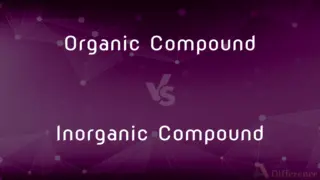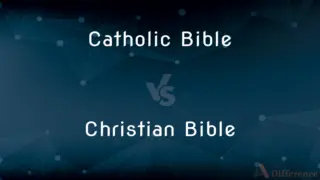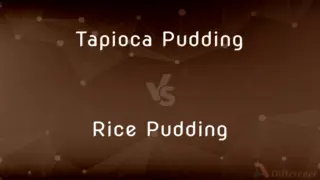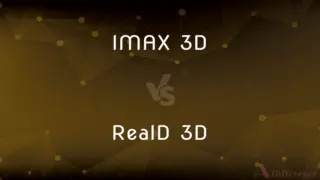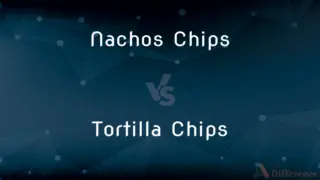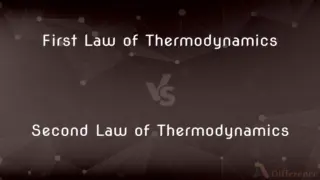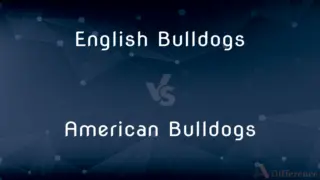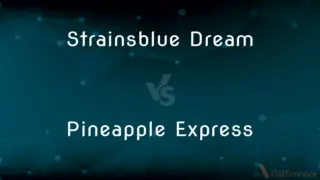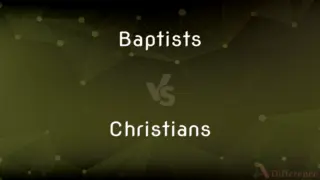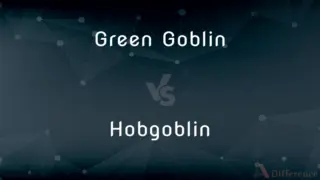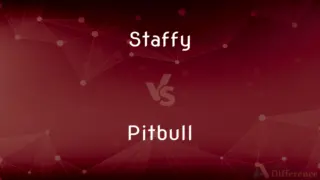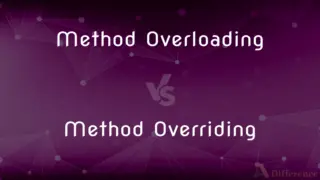Plants vs. Animals — What's the Difference?
Edited by Tayyaba Rehman — By Fiza Rafique — Published on January 12, 2024
Plants are autotrophic organisms that produce their own food via photosynthesis, while animals are heterotrophic and rely on consuming organic material.
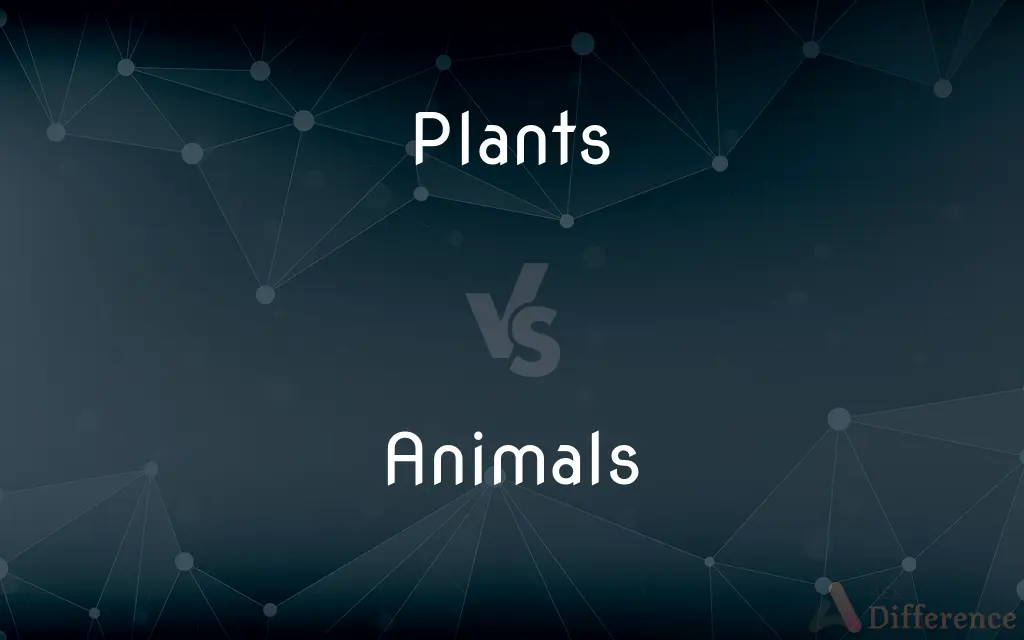
Difference Between Plants and Animals
Table of Contents
ADVERTISEMENT
Key Differences
Plants are organisms that primarily gain energy through the process of photosynthesis, where they convert sunlight, carbon dioxide, and water into sugars. Animals, however, are unable to produce their own food through photosynthesis and must consume plants or other animals to gain energy. This fundamental difference outlines the roles they play in the ecosystem, with plants often being producers and animals being consumers.
In terms of cellular differences, plants have rigid cell walls made of cellulose that maintain cell shape and support the structure of the plant. Animals lack these rigid cell walls, having more flexible cell membranes instead. This gives animal cells the ability to adapt to various shapes and allows for a greater diversity of cell types and functions.
Reproduction in plants can occur through various methods, including sexually and asexually. Plant sexual reproduction typically involves flowers and the creation of seeds, while asexual reproduction can include budding or vegetative propagation. Animals primarily reproduce sexually, though some species are capable of asexual reproduction. Sexual reproduction in animals involves the combination of genetic material from two individuals to produce offspring.
Plants typically do not have nervous systems and are sessile, meaning they do not move from place to place. Animals usually have a nervous system and are motile, moving actively in their environment. The sensory and nervous systems in animals allow them to respond quickly to stimuli, a feature not found in plants.
The life cycles of plants and animals can also differ greatly. Many plants go through a life cycle that includes a shift between diploid and haploid stages, known as alternation of generations. Animals typically have a life cycle that remains in the diploid stage after embryonic development, only producing haploid cells during gametogenesis for reproduction.
ADVERTISEMENT
Comparison Chart
Cell Structure
Have cell walls made of cellulose.
Do not have cell walls; have cell membranes.
Energy Acquisition
Autotrophic; produce their own food.
Heterotrophic; consume organic material.
Mobility
Sessile; do not move from place to place.
Motile; move actively.
Reproduction
Can reproduce sexually and asexually.
Primarily reproduce sexually.
Growth
Grow throughout life, mainly at tips.
Grow to a certain size, often stop after maturity.
Nervous System
Lack a nervous system.
Have a nervous system for response to stimuli.
Compare with Definitions
Plants
Plants provide oxygen and food, which are essential for life on Earth, and they also contribute to the carbon cycle.
Plants release oxygen into the atmosphere, which is vital for animal respiration.
Animals
Animals reproduce primarily sexually, with a small percentage capable of asexual reproduction.
Most animals have intricate mating rituals to attract partners for sexual reproduction.
Plants
Plants are characterized by their ability to produce their own food through photosynthesis and have a cell wall.
The plants on the forest floor compete for light to carry out photosynthesis.
Animals
Animals belong to the biological kingdom Animalia, and they are characterized by their sensory and nervous systems.
The complexity of animals' behavior is often attributed to their advanced nervous systems.
Plants
Plants are predominantly multicellular organisms that grow in soil and are a crucial part of the Earth's ecosystem.
Native plants often require less water and are better for local wildlife.
Animals
Animals range from simple invertebrates like worms to complex vertebrates like humans, exhibiting diverse life forms.
The ocean is home to some of the most bizarre animals, many yet to be discovered.
Plants
Plants include a vast diversity of flora, ranging from trees and flowers to bushes and grasses.
Tropical regions have a rich diversity of plants not found in other climates.
Animals
Animals are multicellular, eukaryotic organisms that consume organic material, breathe oxygen, and are able to move.
Animals in the savannah include lions, zebras, and elephants.
Plants
Plants are living organisms that belong to the kingdom Plantae, which photosynthesize sunlight into energy.
The plants in my garden are thriving due to the abundance of sunshine.
Animals
Any of numerous multicellular eukaryotic organisms of the kingdom Metazoa (or Animalia) that ingest food rather than manufacturing it themselves and are usually able to move about during at least part of their life cycle. Sponges, jellyfishes, flatworms, mollusks, arthropods, and vertebrates are animals.
Plants
Any of various photosynthetic, eukaryotic, multicellular organisms of the kingdom Plantae characteristically containing chloroplasts, having cell walls made of cellulose, producing embryos, and lacking the power of locomotion. Plants include trees, bushes, herbs, ferns, mosses, and certain green algae.
Animals
An animal organism other than a human, especially a mammal.
Plants
A plant having no permanent woody stem; an herb.
Animals
A person who behaves in a bestial or brutish manner.
Plants
Any of various fungi, algae, or protists that resemble plants and were formerly classified in the plant kingdom. Not in scientific use.
Animals
A human considered with respect to their physical nature, as opposed to rational or spiritual nature.
Plants
A building or group of buildings for the manufacture of a product; a factory
Works in an auto plant.
Animals
A person having a specified aptitude or set of interests
“that rarest of musical animals, an instrumentalist who is as comfortable on a podium with a stick as he is playing his instrument” (Lon Tuck).
Plants
The buildings, fixtures, and equipment, including machinery, tools, and instruments, necessary for an industrial operation or an institution
The university's mechanical plant.
Animals
Relating to, characteristic of, or derived from an animal or animals, especially when not human
Animal cells.
Animal welfare.
Plants
A person placed in a group of spectators to influence behavior.
Animals
Relating to the physical as distinct from the rational or spiritual nature of people
Animal instincts and desires.
Plants
A person stationed in a given location as a spy or observer.
Animals
Plural of animal
Plants
A misleading piece of evidence placed so as to be discovered.
Animals
Animals are capable of voluntary movement and interact with their environment in complex ways.
Animals have adapted to survive in virtually every ecosystem on Earth.
Plants
A remark or action in a play or narrative that becomes important later.
Plants
(Slang) A scheming trick; a swindle.
Plants
To place or set (seeds, for example) in the ground to grow.
Plants
To place seeds or young plants in (land); sow
Plant a field in corn.
Plants
To place (spawn or young fish) in water or an underwater bed for cultivation
Plant oysters.
Plants
To stock with spawn or fish.
Plants
To introduce (an animal) into an area.
Plants
To place or fix in a certain position
Planted both feet on the ground.
Planted a kiss on my cheek.
Plants
To deliver (a punch or blow).
Plants
To fix firmly in the mind; implant
"The right of revolution is planted in the heart of man" (Clarence Darrow).
Plants
To establish; found
Plant a colony.
Plants
To station (a person) for the purpose of functioning in secret, as by observing, spying, or influencing behavior
Detectives were planted all over the store.
Plants
To place secretly or deceptively so as to be discovered or made public
Planted a gun on the corpse to make the death look like suicide.
Plants
To conceal; hide
Planted the stolen goods in the warehouse.
Plants
Plural of plant
Common Curiosities
Are all plants green?
Most plants are green due to chlorophyll, but some plants lack chlorophyll and are not green.
Can plants live without animals?
Many plants can survive without animals, though animals often play roles in pollination and seed dispersal.
Are fungi classified as plants?
No, fungi are a separate kingdom of their own and are not classified as plants.
What distinguishes plants from animals?
Plants are primarily photosynthetic and stationary, while animals are non-photosynthetic and most have the ability to move.
Do all animals eat plants?
Not all animals eat plants; some are carnivorous and eat other animals, while others are omnivorous and eat both plants and animals.
How do plants reproduce?
Plants can reproduce sexually through seeds or asexually through methods like cuttings or runners.
Can plants feel pain?
Plants do not have nervous systems like animals, so they do not feel pain in the way animals do.
Why are plants important to animals?
Plants provide oxygen, food, and habitats for animals, making them essential for animal survival.
How do animals adapt to their environment?
Animals adapt through behavioral, physiological, and anatomical changes that improve their survival and reproduction.
Do plants have a life span?
Yes, plants have varying life spans, from annuals that live one season to perennials that live for many years.
Are all animals mobile?
Most animals are capable of movement, but some, like sponges, are sessile and do not move once they are adults.
Do animals contribute to plant reproduction?
Yes, many animals contribute to plant reproduction by pollinating flowers or dispersing seeds.
Are there any animals that photosynthesize?
Some animals have symbiotic relationships with photosynthetic organisms, but they do not photosynthesize themselves.
Do plants have organs like animals?
Plants have organs such as roots, stems, and leaves, which differ in structure and function from animal organs.
Can animals survive without plants?
Animals, especially herbivores, rely on plants for food and oxygen, making it difficult to survive without them.
Share Your Discovery

Previous Comparison
Public Relations vs. Marketing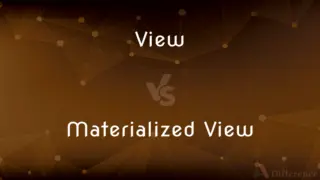
Next Comparison
View vs. Materialized ViewAuthor Spotlight
Written by
Fiza RafiqueFiza Rafique is a skilled content writer at AskDifference.com, where she meticulously refines and enhances written pieces. Drawing from her vast editorial expertise, Fiza ensures clarity, accuracy, and precision in every article. Passionate about language, she continually seeks to elevate the quality of content for readers worldwide.
Edited by
Tayyaba RehmanTayyaba Rehman is a distinguished writer, currently serving as a primary contributor to askdifference.com. As a researcher in semantics and etymology, Tayyaba's passion for the complexity of languages and their distinctions has found a perfect home on the platform. Tayyaba delves into the intricacies of language, distinguishing between commonly confused words and phrases, thereby providing clarity for readers worldwide.













